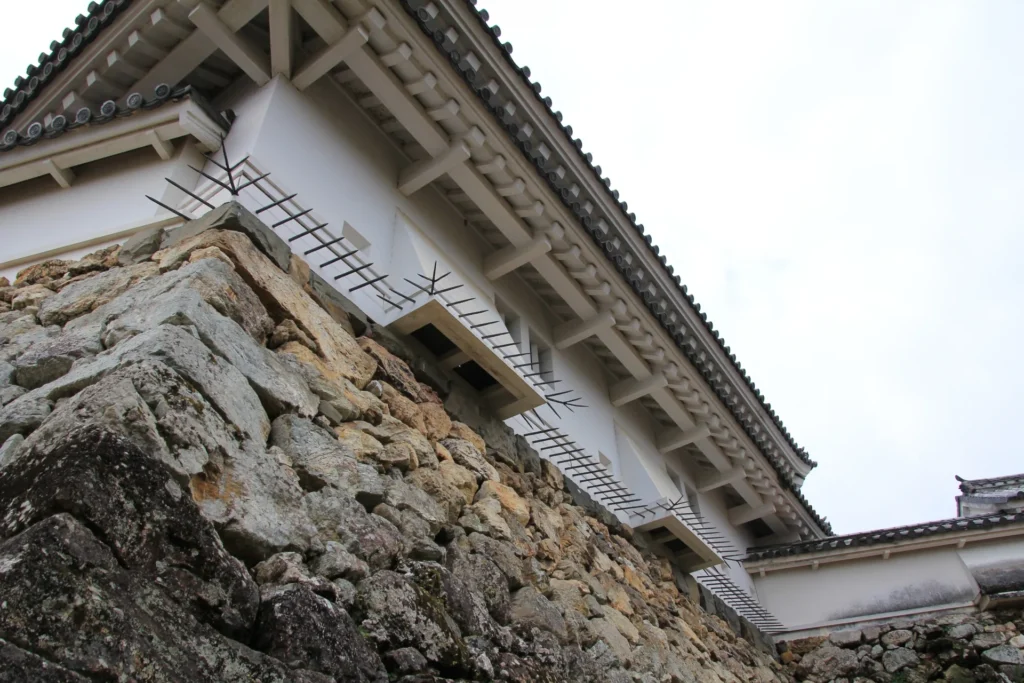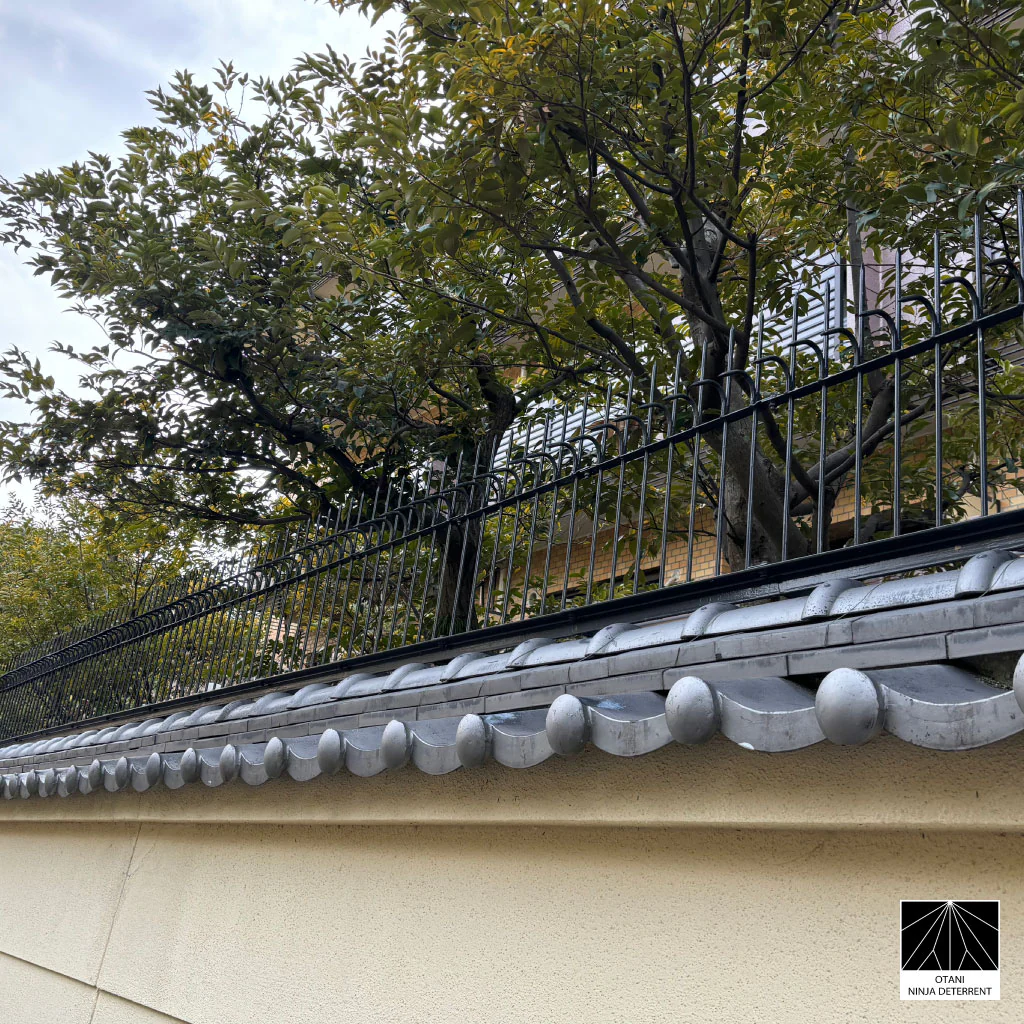The History of Ninja Deterrent™︎
The Quiet Legacy of Shinobi Gaeshi
Though shinobi gaeshi (忍び返し) may appears to be a familiar feature of traditional Japanese architecture, its history remains surprisingly untold. The term literally means “to repel intruders” a phrase that might conjure images of ninja yet extends far beyond them. It refers to the discreet metal spikes or barriers installed along walls, fences, and eaves to discourage unwanted entry— an unassuming but effective element of Japan”s exterior design heritage.
In reimagining this uniquely Japanese artifact for the modern age, we founded the international brand name Ninja Deterrent™—a contemporay expression of “shinobi gaeshi (忍び返し),” While the translation is literal, the intent is broader: to embody the ideal of aesthetic, non-lethal deterrence rooted in centuries of architectural wisdom.
Even within Japan, little has been written about shinobi gaeshi (忍び返し). According to Japan’s National Diet Library, only 29 bibliographic records exist on among more than 47.53 million catalogued works. By contrast, the term “manhole” appears over 1,808 times—a striking reminder of how quietly this subject has been overlooked.
Yet the philosophy behind shinobi gaeshi is both simple and timeless:
Reduce the chance of intrusion to protect what lies within.
Throughout human history—marked by conflict, conquest, and the desire for safety—deterrence has always played a vital role. But in Japan, this instinct for protection has long been tempered by grace, balance, and a deep respect for harmony with the built environment.
In the pages that follow, we invite you to explore the evolution of shinobi gaeshi (忍び返し)— quiet guardians of form and function, shaped by the enduring artistry of Japan’s design.
The Origin of Shinobi Gaeshi
From the Warring States to Edo Period (15th–18th Century)

As its name implies, Ninja Deterrent traces its root to a traditional Japanese security device created to prevent and repel intruders— whether covert agents, thrives, or other unwelcome visitors. Its origins are believed to predate Japan’s Warring States period, when simple, spire-shaped iron fittings were installed on the walls and gates of castles and samurai residences. These early forms are regarded as the prototypes of what would later be known as shinobi gaeshi (忍び返し)— the quiet guardians of an age defined by vigilance and refinement.

During the Edo period, shinobi gaeshi evolved beyond mere protection. Decorative forms featuring family crests and refined geometric patterns began to appear on the residences of samurai and feudal lords, merging security with artistry. Master blacksmiths forged these intricate designs, often arranging them in continuous lines along the tiled eaves of turrets— creating a balance between imposing presence and architectural grace.
Though their silhouettes resembled sharp blades these Edo-period deterrents embodied more than defense. They stood as symbols of dignity and refinement— quiet expressions of the prestige and discipline of the samurai class.
Widespread Use of Shinobi Gaeshi
From the Meiji Restoration to Early Shōwa (19th–20th Century)

With the Meiji Restoration, Japan entered an age of modernization and peace. As the need for castle defense declined, shinobi gaeshi found new life in urban landscape— gracing townhouses, merchant estates, and the homes of the affluent.
In castle towns such as Tokyo, Kyoto, and Osaka, these metalworks were installed along walls and gates as discreet elements of urban security. No longer instruments of war they because expressions of craftsmanship and quiet dignity— functional details that blended seamlessly into the evolving cityscape, reflecting both protection and refinement.
From the Taishō period to the early Shōwa period, Japan entered and era of transformation— shaped by Western influence and rapid industrial growth. New materials and techniques, such as cast iron and pressed steel, gave rise to mass-produced designs that reflected the spirit of modernity. Amid this wave of progress, craftsmen and manufacturers began reinterpreting traditional Japanese motifs through contemporary methods. These refined yet accessible creations blended security with decoration, allowing the quiet elegance of shinobi gaeshi to reach homes far beyond the samurai class.
Modern Application
From the Late 20th Century to the Present

Since the late Shōwa period, materials with excellent weather and corrosion resistance, such as stainless steel, have been introduced, dramatically improving rust prevention and maintenance. Additionally, collaborations with architectural designers and landscape architects have led to the creation of modern art-like forms and elegant designs blending Japanese and Western styles.
From the late Shōwa period onward, advances in materials brought new possibilities to shinobi gaeshi. The introduction of stainless steel and other weather-resistant metals greatly enhanced durability and ease of maintenance, ensuring lasting beauty through time and season.
In recent decades, collaborations with architects and landscape designers have given rise to forms that transcend mere function—modern expressions that blend Japanese subtlety with Western aesthetics. What was once a quiet instrument of protection has evolved into an architectural statement: a fusion of tradition, innovation, and enduring grace.

In recent years, design approaches rooted in CPTED (Crime Prevention Through Environmental Design) theory have been embraced— integrating smart functions such as lighting, surveillance systems, and motion sensors. These advancements merge technology with the timeless principles of spatial harmony, allowing shinobi gaeshi to evolve in both form and intelligence.
Today, this reimagined expression of Japanese security culture has begun to capture attention in luxury residential and commercial projects around the world—quietly expanding its presence as a symbol of protection refined through beauty.
Ninja Deterrent™︎, which harmoniously balances the aesthetic appeal of “visible security” with the practical functionality of “physical barriers,” stands not merely as a metal fixture—but as an form that unites beauty and purpose. Seamlessly integrated into architecture, it embodies the Japanese spirit of refinement, precision, and quiet strength. As it continues to evolve, Ninja Deterrent™︎ transcends its role as a defensive element, becoming a statement design where tradition and innovation coexist in perfect harmony.
We invite you to discover how technological innovation and evolving aesthetic sensibilities have shaped each era.
Through this journey, may you gain a deeper appreciation for the profound allure of Ninja-inspired security—and the timeless essence of beautiful protection, where elegance and strength coexist in perfect balance.